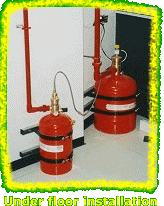|
Decommissioning Halon systems - The safe approach
|
The following points should be addressed in the Risk Assessments and Method Statement provided by any contractor engaged to decommission an existing halon system.
Depending upon the number of days the works are expected to take - CDM
(Constructions Design Management) Regulations may need to be employed. You will need to appoint a Principle
Contractor, a Planning Supervisor and don't forget to file an F10 with the HSE
(Health & Safety Executive) at you local office.
Risks Associated with Decommissioning and therefore Assessments must be carried out. -
Risks associated with pressurised cylinders -
Risks associated with manual handling of heavy objects -
Risks associated with halon exposure |

|
The method statement should cover the following topics (Procedures detailed in the method statement must be cross checked with that detailed by the manufacturer's
Owner's, Service, Operation, and Maintenance manuals). -
Correct security of cylinders before work commences -
Disconnection of Actuation Devices -
Disconnection of pipework / manifolds and the making safe by use of Protective Caps
(Anti-Recoil Devices) -
Protecting, securing and packing cylinders for transport -
Adequate receiving facilities for transported cylinders
Security of cylinders in installed location:
Before any works are carried out, ensure that all cylinders are securely attached to a solid surface such as a wall or the floor with the factory supplied retaining
brackets.
Disconnect Actuation Circuits / Devices:
Isolate as appropriate to the system actuation device and then disconnect. This will vary with the manufacturer of the
equipment. The method statement should detail these actions in depth.
Disconnect Discharge Piping: The pipework may be connected directly or multiple cylinders may have manifold
arrangements. Take great care not to impose strain on the valve itself - this could lead to a leak of
halon.
Fit transport Plugs:
These should prevent recoil in the event that the valve operates after pipework is
disconnected. Most cylinders are charged to 25 bar (360 psi) if the valve operated without the protection cap the cylinder could become a projectile and could easily injure or kill
somebody.
Protecting, securing and packing cylinders for transport:
The cylinders should be adequately protected for transport and secured during
transit. The contractor may need to be registered to carry this equipment as
Waste.
Finally:
Make sure that if there is a detection system associated with the old halon system - It
works. Notify the responsible person that the facility is no longer protected with an
extinguishant. This should include the removal of any signage, manual release points and status
units. |



